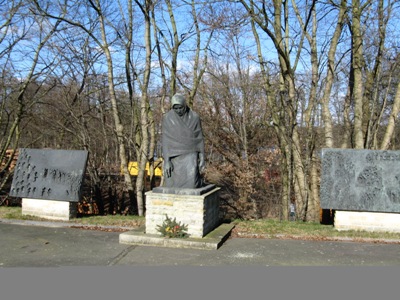Memorial Death March Störkanal "De Mother"
The monument "The Mother" commemorates the victims of the death marches following the evacuation of Sachenhausen and other concentration camps in 1945. Unveiled in 1973 and created by East Berlin artist Gerard Thieme, the monument consists of a statue of a kneeling mother flanked by 4 bronze reliefs. The reliefs depict the liberation of prisoners by the Red Army, and this is a clear example of framing of history by the then GDR. The reality was much more nuanced but it did not fit the GDR's image.
The evacuation of Sachenhausen began on 20 April 1945. Weakened and with completely inadequate clothing and insufficient food, some 33,000 prisoners, including women and children, marched in columns through northern Brandenburg and Mecklenburg. They had to walk up to 40 kilometres every day in cold, wet weather and slept in overcrowded barns or in the open. Those who could not continue were shot or beaten to death by SS guards. This fate also threatened prisoners who tried to get some food or water by the roadside. Only a few prisoners managed to escape the heavily guarded columns. The columns moved through towns and villages, along forest paths as well as densely populated country roads, where they encountered refugees and retreating Wehrmacht soldiers. Most onlookers reacted indifferently and only a few offered help.
The columns moved along several routes towards Wittstock and into an increasingly narrow corridor that was still in German hands. In the Belower Forest north of the city, on 23 April 1945 and the following days, the SS gathered more than 16,000 prisoners in a provisional camp partially fenced with barbed wire. SS guards surrounded the part of the forest and left those inside to their fate, without food, water or shelter.
Most prisoners, however, had to walk further northwest in columns that left the forest on 29 April. Near the town of Crivitz, most of the prisoners from Sachsenhausen met women from Ravensbrück concentration camp, who had ended up there during their death march. Other columns were forced to walk to Ludwigslust. The closer the front lines approached, the more the order of the march disintegrated as more and more SS guards slipped away.
Most prisoners were not freed in the literal sense but were simply left behind by the SS. They were only really in safety when the Soviets and Americans met at the Stör Canal near Raben Steinfeld on 4 May. Depending on where the different groups of prisoners were between 2 and 4 May, they were liberated by either the Soviet or US army.
Do you have more information about this location? Inform us!





